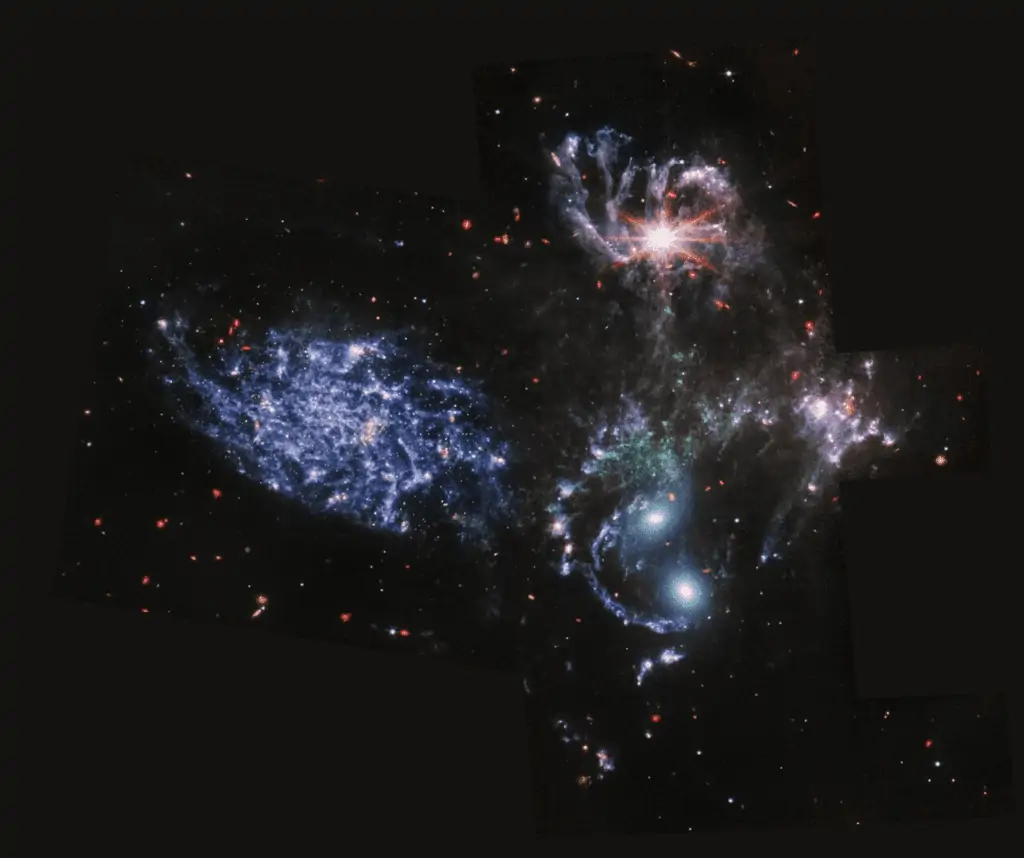Dear friends,
“At your command all things came to be: the vast expanse of interstellar space, galaxies, suns, the planets in their courses, and this fragile earth, our island home.”
These words from Eucharistic Prayer C (written in 1969 in response to the first moon landing) have been going through my head all week as I’ve looked in awe at the first photos from the James Webb Space Telescope.
Our parishioner astrophysicist Dr. Misty Bentz, is one of 13 scientists in the world awarded observing time for the telescope. She will be testing the capability of JWST for measuring the masses of nearby supermassive black holes in active galaxies. (Here is a link to more information about her research: https://news.gsu.edu/2017/12/05/nasas-next-big-thing/).
I asked Misty to tell us how she has felt this week after seeing the first photos from JWST, and to explain their significance. Here is what she wrote. And please click on the links to see the high resolution photos and zoom in on them. Even to non-scientists they are amazing.
From Misty:
The last hours have been exhilarating and exhausting. A surprise unveiling of the first image from the James Webb Space Telescope (JWST) by President Biden was announced barely 24 hours before it occurred. Planned for Monday at 5 pm EDT, the event actually started around 6:10 pm EDT. Every astronomer I know was sharing memes and cracking jokes on social media in the intervening hour, demonstrating both creativity and extreme nerdiness, while good naturedly complaining about the elevator hold music on NASA TV and waiting for the big reveal.
And big it was. While the presentation left something to be desired, especially with its nationalistic focus in describing this international endeavor, the image itself did not disappoint (high resolution version available here: https://www.nasa.gov/image-feature/goddard/2022/nasa-s-webb-delivers-deepest-infrared-image-of-universe-yet). Every smudge and point of light in the image, except for the handful of six-pointed stars that are in our galaxy and photobombing our view, is a galaxy. A galaxy not so different from the Milky Way, composed of trillions of stars and their planets. And they are EVERYWHERE in this image. More and more become visible as you zoom in, of all different shapes, sizes, colors, and distances, and most have never been seen by humans before. Ever. Not only that, but the arcs and streaks in the image are distorted images of background galaxies. The mass in the whitish cluster of galaxies at the image center acts like a funhouse mirror in a process known as gravitational lensing — the light from the background galaxies is deflected by the mass of the cluster as it passes through on its way to us.

And that was just the first image. We had to wait until Tuesday morning for the remaining four datasets to be revealed, one by one. While the mood Monday night was silly and goofy and had the feeling of being a teenager at the movie theater throwing popcorn at the screen, Tuesday morning I joined an online presentation of the images held at Space Telescope Science Institute — the control center for JWST. Instead of elevator music and memes there was a healthy dose of science and technical details, with no less wonder and amazement as each data set was revealed.
After admiring the deep field image again, we next explored the atmosphere of a planet orbiting another star. (https://www.nasa.gov/image-feature/goddard/2022/nasa-s-webb-reveals-steamy-atmosphere-of-distant-planet-in-detail) This time we saw a spectrum instead of a picture. The amount of light at different wavelengths in the atmosphere of this exoplanet tells us about its chemical composition, and there is clearly water there. But this is not a planet that we can visit — at 1150 light years away, we have no hope of ever getting there, and it is a gas giant anyway (kind of like Jupiter) with no solid surface.

Next to be revealed was the Southern Ring Nebula, a dying star that is slowly puffing off its outer layers like Alice’s caterpillar puffed out smoke rings (https://www.nasa.gov/image-feature/goddard/2022/nasa-s-webb-captures-dying-star-s-final-performance-in-fine-detail). Here we have two separate images, one at shorter wavelengths (from NIRCam on the left) and one at longer wavelengths (from MIRI on the right). The mind-bending amount of detail in this planetary nebula is worth as much time as you have available to stare at it, zooming all the way in and slowly panning around. And we even got our first glimpse of the dying star itself. It’s not the bright point just off the center of the nebula, but the fainter red point in the center of the MIRI (right side) image .

Taking ourselves back to larger scales, we next admired Stephan’s Quintet, a group of galaxies that are undergoing a destructive gravitational dance (https://www.nasa.gov/image-feature/goddard/2022/nasa-s-webb-sheds-light-on-galaxy-evolution-black-holes). You can see the arm of one galaxy being ripped off to the side, and note that you can zoom in and see individual stars in the arm as well as background galaxies peeping through it. Below and to the left is a galaxy that is between us and the Quintet and is not actually involved in the gravitational drama. Here, as you zoom in you notice that the galaxy itself is resolved into individual stars and you can see ALL THE WAY THROUGH IT. And to the right of that is an absolute train wreck of two galaxies and scattered blobs of hot glowing gas. Here again we have both NIRCam and MIRI imaging, and while they are combined together in the main image that was released today, there is a surprise if you look at the MIRI image by itself (https://esawebb.org/images/weic2208b/). That red star-like thing in the middle of the top right galaxy is light from the superheated gas around an accreting supermassive black hole, hidden behind walls of thick dust and completely invisible in Hubble images!


Finally, we ended Tuesday morning’s tour with a truly awe-inspiring view of the Carina Nebula, a stellar nursery where baby stars and planets are born from the ashes of previous generations (https://www.nasa.gov/image-feature/goddard/2022/nasa-s-webb-reveals-cosmic-cliffs-glittering-landscape-of-star-birth). The brown swirls and pillars are dust cocoons with still-forming stars embedded inside, while a sprinkling of foreground stars showboat out front and the whole scene is illuminated with the hot blue glow of newly born stars that is also steadily eroding away the outer layers of the cocoons.

At the end of it all, I was asked to describe how I was feeling. And it took me a few minutes to identify the individual emotions. Relief that the telescope and instruments are working so well. Joy to be present in this moment and part of the community of explorers seeking to understand our place in the universe as well as ourselves. Curiosity driving me to dive into these data and start uncovering all the surprises they still hold. Wonder in the beauty and power, the creation and destruction, that surround us and are part of us. Pride in my colleagues across the world who have worked so hard and so long to accomplish this amazing feat and usher in a new era of discovery.
If you have managed to read this far, I want to leave you with this beautiful reflection on the JWST images by science writer Shannon Stirone (https://www.nytimes.com/2022/07/12/opinion/nasa-james-webb-space-telescope-awe.html). And encourage you to spend some time exploring each of these amazing data sets yourself, and marveling at the wonders that we can explore together when we work together for a common goal.
Thank you, Misty!
